ABOUT AUTHORS:
Vishwanadham Yerragunta*1, Duggi.Suman1, Kumara swamy1, V.Anusha1, Pratima Patil1, M. Naresh2
Department of Pharmaceutical Chemistry,
1Malla Reddy College of Pharmacy, Maisammaguda, Secunderabad-500014, A.P.
2Bharath Institute of Technology Pharmacy-Ibrahimpatnam, AP.
*vishwanadham.y@gmail.com
{ DOWNLOAD AS PDF }
ABSTRACT:
The aim of this review is to provide an overview of diverse pharmacological activities of pyrazole moiety. Pyrazole are well known and important nitrogen containing 5-membered heterocyclic compounds and various methods have been worked out for their synthesis. Pyrazole chemically known as 1, 2-diazole has become a popular topic due to its manifold uses. Numerous pyrazole derivatives have been found to possess a broad spectrum of biological activities, which stimulated the research activity in this field. Pyrazoles and its derivatives represent one of the most active classes of compounds, which possess wide range of biological activities like anti-bacterial, anti-convulsant, analgesic, anti-microbial, anti-inflammatory, ant diabetic, sedative anti-rheumatic, anticancer, and anti-tubercular activities. The purpose of this review was to collate literature work reported by researchers on pyrazole for their various pharmacological activities and also reported recent efforts made on this moiety.
REFERENCE ID: PHARMATUTOR-ART-2073
INTRODUCTION:
The chemistry of pyrazoles has been extensively investigated in the past. Pyrazoles are five member ring heterocyclic compounds, have some structural features with two nitrogen atoms in adjacent position and are also called as azoles1.

The chemical reactivity of the pyrazole molecule can be explained by the effect of individual atoms. The N-atom at position 2 with two electrons is basic and therefore reacts with electrophiles. The N-atom at position 1 is unreactive, but loses its proton in the presence of base. The combined two N-atoms reduce the charge density at C3 and C5, making C4 available for electrophilic attack. Deprotonation at C3can occur in the presence of strong base, leading to ring opening. Protonation of pyrazoles leads to pyrazolium cations that are less likely to undergo electrophilic attack at C4, but attack at C3 is facilitated. The pyrazole anion is much less reactive toward nucleophiles, but the reactivity to electrophiles is increased2
Pyrazoles are aromatic molecules due to their planar conjugated ring structures with six delocalized π-electrons. Therefore, many important properties of these molecules were analyzed by comparing with the properties of benzene derivatives3. Like other nitrogen involving heterocycles, different tautomeric structures can be written for pyrazoles. unsubstituted pyrazole can be represented in three tautomeric forms4.

Tautomeric forms of unsubstituted pyrazole.
Now a day’s vast number of compounds with pyrazole nucleus have been reported to show a broad spectrum of biological activity including. antimicrobial5, antiviral6, anti-tumor7,8, anti-histaminic9, anti-depressant10, insecticides11 and fungicides11. Due to its wide range of biological activity, pyrazoles ring constitutes a relevant synthetic route in pharmaceutical industry. In fact, such a heterocyclic moiety represents the core structure for number of drugs
LITERATURE:
· Eman M. Flefel et.al have reported the new substituted pyrazole, thiazole, and 1, 2, 4-triazole derivatives were synthesized. The sugar hydrazones, their acetylated derivatives as well as their derived acyclic C-nucleoside analogs, and the thioglycosides of the 1, 2, 4-traizole derivatives were also prepared. The antitumor activity of some of the synthesized compounds were studied, and a number of the tested compounds showed significant activities12.
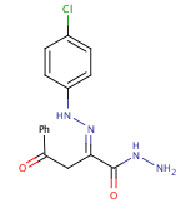
· Mohamedsalahk.youssef et.al., have synthesized Ethyl 7-amino-3-(3-methyl-5-oxo-1-phenyl-2-pyrazolin-4-yl)-5-aryl-5H-thiazolo[3,2-a]pyrimidine-6-carboxylate was synthesized by the reaction of 4-(2-aminothiazol-4-yl)-3-methyl-5-oxo-1-phenyl-2-pyrazoline with arylidene ethyl cyanoacetate and it transformed to related fused heterocyclic systems via reaction with various reagents13.
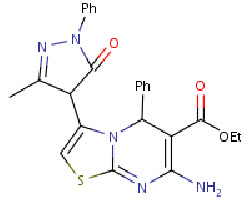
· Rao Jyothi et al., have synthesized a novel series of 1, 3, 5-trisubstituted pyrazoles by the cyclo condensation reaction of chalcones and substituted hydrazides by irradiation under microwave energy and also by conventional method. Compound 3g showed good activity against E. coli and P.aerugiosa. Compound 3j showed good activity against the fungus A. fumigatus14.
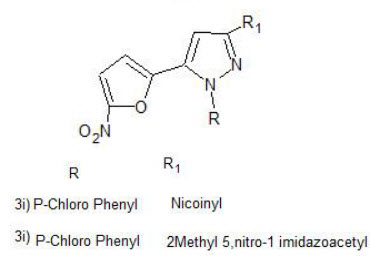
· Sagar K. Mishra et al., have reported the synthesis of a series of 1- (2, 4-dinitrophenyl)-3-(3-nitrophenyl)-5-(4-substituted phenyl)-2-pyrazolin-4-ones by the oxidation of 1-(2, 4-dinitrophenyl)-3-(3-nitrophenyl)-5-(4-substituted phenyl) - 4-bromo-2-pyrazolines with dimethyl-sulfoxide and assayed for in vitro antimicrobial activity. Most of the synthesized compounds did not exhibit significant inhibitory activity against the tested strains15.
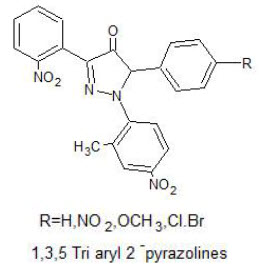
· SatheeshaRai N and BalakrishnaKalluraya et.al., have reported novel series of nitrofuran containing 1,3,4,5 tetra substituted pyrazole derivatives. Compound 3b showed highest anti-bacterial and antifungal activity than all other compounds16.
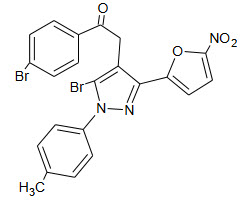
· Sahu SK et al., have synthesized a series of novel 4-(5-substituted aryl-4, 5-dihydropyrazole-3-yl-amino) phenols by treating substituted aryl-N-chalconyl amino phenols with hydrazine hydrate. It was observed increase in analgesic, anti-inflammatory and anti -microbial activities are attributed to the presence of 4-NO2, 2-OH and 4-Cl in phenyl ring at 5-position of pyrazoline ring of synthesized compounds17.
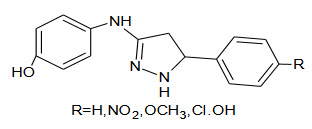
· Argade N. D et al., have reported the conventional microwave assistance Synthesis of pyrazole containing 2, 4-disubstituted oxazol-5-one as a new class of antimicrobial agents. Compared to the conventional method, the microwave- assisted synthesis demonstrates several advantages, in terms of reaction time and overall yield. Compounds with electron withdrawing groups showed good antibacterial and antifungal activities. Among the compound tested, compound (3d) showed highest activity18.
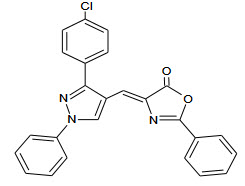
· Chovatia P. T et al., have synthesized derivatives and these compounds were tested in vitro for their anti-tubercular and antimicrobial activities19.
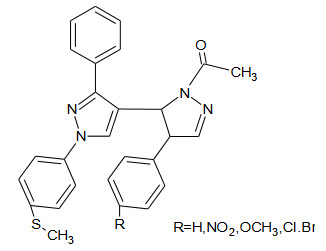
· Kuntal Manna et al., have reported that, the microwave-assisted synthesis in having higher regioselective, and more time saving than ordinary synthesis of pyrazoline containing benzofuran with indo phenazine ring. The potency and selective compounds make them valid leads for synthesizing new compounds with better activity and exhibiting lower MICs values20.
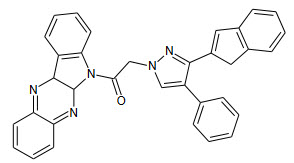
· Mari Sithambaram Karthikeya et al., have synthesized chloro-fluorine containing hydroxypyrazolines from chloro-fluorine containing chalcones. Chalconedibromides were obtained by the bromination of chalcones at room temperature. Treatment of chalconedibromides with aryloxy acid hydrazides in the presence of triethylamine gave chloro-fluorinecontaining hydroxyl pyrazolines (6). Some compounds showed very good antibacterial activity and antifungal activity21.
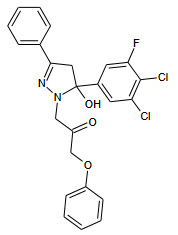
· Venkat Ragavan R et al., have synthesized A group of novel 1,5-diaryl pyrazoles by altering the active part (amide linkage) and tested for their biological activities. The results of our present study conferred that the aliphatic amide pharmacophore is important for antimicrobial activities of studied pyrazoles specifically the presence of 4-piperidine moiety enhances the activities. Compounds exhibited good antibacterial and antifungal activity22.
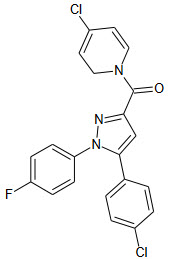
· Giulia Menozzi et al., during the course of their studies in the azole antifungal area, they synthesized a number of 1, 5-disubstituted-1H-pyrazoles, analogues of bifonazole.1, 5-Diphenyl-1H-pyrazole 3 showed weak anti mycotic and antibacterial activities invitro. In order to increase these properties, given that the halo substitution was found to be capable of enhancing antifungal effects, they prepared a series of fluoro and chloro derivatives of 3. Some dichloro and trichloro derivatives showed interesting antimicrobial properties23.
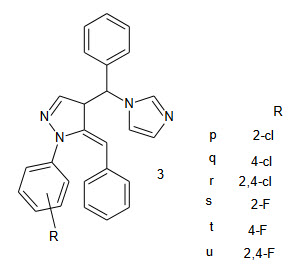
· Nesrin Gokhan-Kelekci et al., have synthesized a 1-thiocarbomyl-3-substituted phenyl-5-(2-pyrole)-4, 5-dihydro-(1H)-derivatives and investigated for their ability to inhibit MAO. Most of the compounds showed high activity against MAO. In addition anti- inflammatory and analgesics activity were determined. Compound (3k) exhibited both anti-inflammatory and analgesics activity comparable to that of indomethacin with no ulcerogenic effect24.
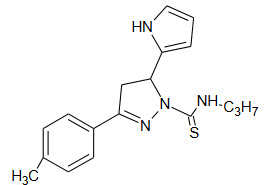
· Ezawa M et al., have synthesized 4-{3-[(1Z)-4- (nitrooxy) but-1-enyl]-5-(3-pyridyl)pyrazolyl}-1-(4-methylsulfonyl)benzene (9) and its COX-2 inhibitory potency. A nitric oxide (NO)-donating group at the 3-position of the pyrazole ring was synthesized and evaluated for its ability to inhibit COX isozymes in human whole blood. They have observed that in the pyrazole class of COX-2 selectiveinhibitors 3-pyridyl modified 1, 5-disubstituted pyrazole compound 9 containing aNO-donating group at the 3-position of the pyrazole ring exhibited appreciable COX-2 potency and selectivity25.
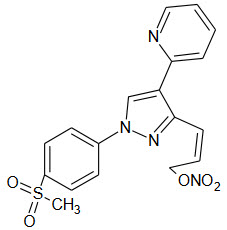
· Giuseppe Cocconcelli et al., have described the parallel synthesis of aryl azoles. Here substituted phenyl hydrazine is made to react with α, β-unsaturated ketones, which leads to regioselective formation of 4, 5-dihydro-1-H-pyrazole and acetic acid was used as catalyst. Compounds (3a and 2g) posseses good neuroprotective activity26.
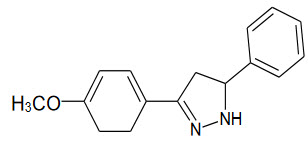
· Fotini Naoum et al., have synthesized novel tetra substituted pyrazole derivatives bearing a nitro substituent on their phenol ring. Among the compound tested 2-nitro phenol derivatives (5c) were found to bind satisfactorily to the estrogen receptor27.
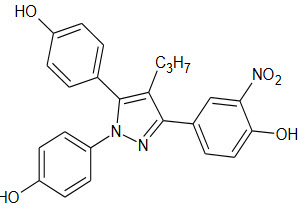
· Parameswaran Manojkumar et al., have reported synthesis of coumarin derivatives containing pyrazole, to elucidate the potential role of these compounds as antioxidants and cytotoxicagents against Dalton’s lymphoma ascites tumour cells (DLA) and Ehrlich ascites carcinoma cells (EAC). Compound (5a) showed promising antioxidant activity invitro and cytotoxic activity against DLA cells and EAC cells28.
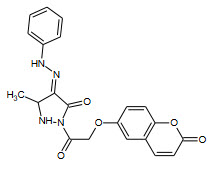
· Laurent Gomez, et al., have reported the synthesis and SAR studies of 1, 5-diarylpyrazole analogs with various structural modifications of the alkane side chain of the molecule and concluded that compound (19) showed good oral bioavailability and could be used for the potential treatment of IBS and other GI disorders29.
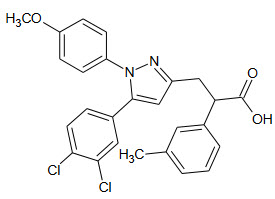
· Vasile Dinoiu, Jian-Ming et.al., synthesized newer fluorine-containing-organic compounds. 3, 5-dialkyl-4-hydroxybenzylhydrazine reacted with hexafluroacetyl acetone, and trifluroacetylacetone yielding the pyrazoles bearing trifluromethyl and/or methyl substituent. The same hydrazine derivatives gave the pyrazole-5-ones with trifluroacetoacetic acid ethyl ester. On oxidation lead to tetraacetate in dichloromethane and aroxyls were obtained30.
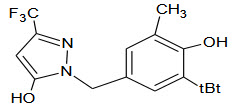
· Sunil Singh K et al., studied the microwave promoted condition and optimized to get a1,5-diaryl-pyrazole and subsequently implemented to the parallel synthesis of different compounds, and they concluded that this was the excellent method for the rapid generation of 1,5-diarylpyrazole using microwave inaqueous medium under normal laboratory condition31.
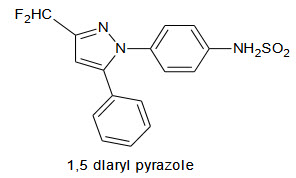
· El-Saied Aly A et al., have shown a new synthetic route for the synthesis of some novel pyrazole derivatives. They prepared some novel pyrazole derivatives by the reaction of 3-aryl-1-phenyl-1H-pyrazolecarbaldehydes as starting material with acylglycine, benzamidine HCl and azidoacetate giving pyrrolopyrazole derivatives32.
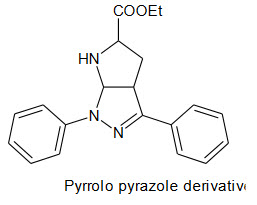
Some of the marketed products of pyrazole nucleus are listed below33.
Table 1:Marketedproducts containing Pyrazole moiety
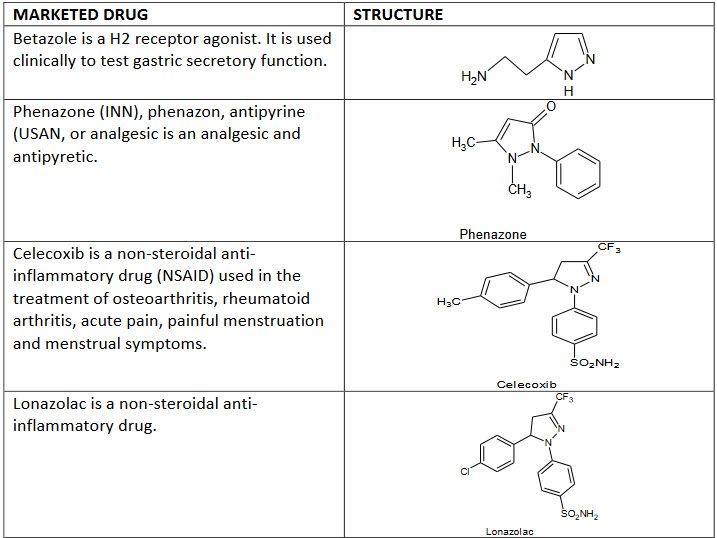
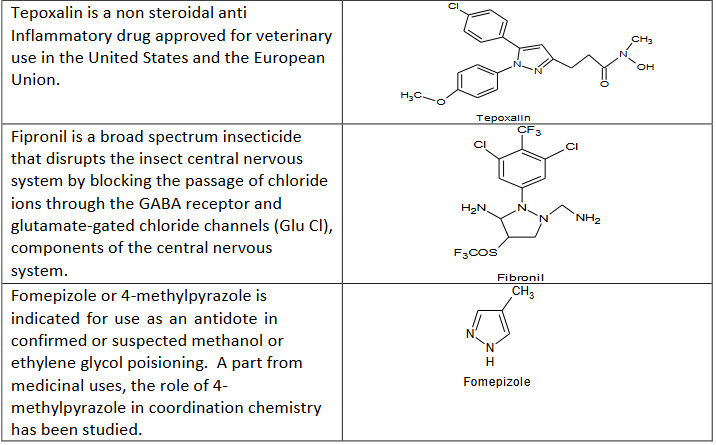
CONCLUSION:
The reviewed Pyrazole is a unique template that is associated with several biological activities. The various substituted pyridine and are having antibacterial, anticonvulsant, analgesic, antimicrobial, anti-inflammatory, ant diabetic, sedative antirheumatic, anticancer, and antitubercular activitiesThis article high lightened research work of many researchers reported in literature for different pharmacological activities on pyrazole compounds synthesized. The review has presented comprehensive details of pyrazole analogues, potent compounds reported for particular pharmacological activity and the method or technique involved in evaluation process. More investigations must be carried out to evaluate more activities of pyrazole for many diseases.
REFERENCES:
1.T, Eicher, S.Hauptmann, Edition IInd, ‘The Chemistry of Heterocycles: Structure, Reactions, Syntheses, and applications’, Wiley-(2003).
2.Raj K Bansal. Heterocyclic chemistry. 4th ed.: New international publishers; 2007.
3.Krygowski, T. M.; Anulewicz, R.; Cyrafiski, M. K.; Puchala, A.; Rasata, D.Tetrahedron, 1998, 54, 12295.
4.Behr, L. C.; Fusco, R.; Jarboe, C. H., The Chemistry of Heterocyclic Chemistry: Pyrazoles, Pyrazolines, Pyrazolidines, Indazoles and CondensedRings; Wiley & Sons: London, 1967.
5.E.V.Pimerova, E.V. Voronina,. Pharm. Chem. J., 2001, 35, 18-20.
6.S.L. Janus; A.Z. Magdif ; B.P. Erik; N.Claus; Chem., 1999, 130, 1167-1174.
7.H.J. Park, K.Lee, S.Park, B. Ahn, J.C.Lee, H.Y. Cho, K.I. Lee. Bioorg. Med. Chem. Lett., 2005, 15, 3307-3312.
8.I.Bouabdallah, L.A M’barek, A. Zyad, A. Ramadan, I.Zidane, A.Melhaoui, Nat. Prod. Res., 2006, 20, 1024-1030.
9.I. Yildirim, N. Ozdemir, Y.Akçamur, M. Dinçer, O.Andaç, Acta Cryst., 2005, E61, 256-258.
10.D.M. Bailey, P.E. Hansen, A.G. Hlavac, E.R. Baizman, J.Pearl, A.F. Defelice, M.E Feigenson, J. Med. Chem., 1985, 28, 256-260.
11.C.K. Chu, J.Cutler, J. Heterocycl. Chem., 1986, 23, 289-319
12.Eman M. Flefel, Waled A. Tantawy, Wael A. El-Sayed*, Hayam H. Sayed, Nahed M. Fathy Journal of Heterocyclic Chemistry Volume pages 344–350, 2013.
13.Mohamed Salah K. Youssef*, Mohamed S. Abbady, Ragaa A. Ahmed, Ahmed A. Omar Journal of Heterocyclic Chemistry Vol 50(2),pages 179–187,2013.
14.Rao Jyothi N, Sujith KV, Kalluraya B. An efficient microwave assisted synthesis of some novel pyrazoles and their biological activity. Saudi Chem. Soc 2008; 12(3):347-52.
15.Sagar K Mishra, Sabuj Sahoo, Prasana K Panda, Satya R Mishra, Raj K Mohanta et al. Synthesis and antimicrobial activity of some 1-(2,4-dinitrophenyl)- 3-(3- nitrophenyl)-5-(4-substituted phenyl)-4-bromo-2-pyrazolines and 1-(2,4- dinitrophenyl)-3-(3-nitrophenyl)-5-(4-substituted phenyl)-2-pyrazolin-4-ones. Acta Poloniae Pharmaceutica and Drug Research 2007; 64 (4): 359-64.
16.Satheesha Rai N, Balakrishna Kalluraya. A novel series of nitrofuran containing 1,3,4,5-tetra substituted pyrazole via 1,3 dipolar addition reaction. Indian j of chem. 2007; 46B: 375-8.
17.Sahu SK, Banerjee M, Samantray A, Behera C, Azaml MA. Synthesis, Analgesic, Anti-inflammatory and Antimicrobial Activities of Some Novel Pyrazoline Derivatives. Tropical Journal of Pharmaceutical Research June 2008; 7 (2): 961-8.
18.Argade ND, Kalrale BK, Gill CH. Microwave Assisted Improved Method for the Synthesis of Pyrazole Containing 2,4,-DisubstitutedOxazole-5-one and their Antimicrobial Activity. E-Journal of Chemistry January 2008; 5 (1): 120-9.
19.Chovatia PT, Akabari JD, Kachhadia PK, Zalavadia PD. Joshi HS. Synthesis and selective antitubercular and antimicrobial inhibitory activity of 1-acetyl-3,5-diphenyl- 4,5-dihydro-(1H)-pyrazole derivatives. J. Serb. Chem. Soc 2007; 71 (7): 713–20.
20.Kuntal Manna, Yadvendra K. Microwave assisted synthesis of new indophenazine 1, 3, 5-trisubstruted pyrazoline derivatives of benzofuran and their antimicrobial activity. Bioorganic & Medicinal Chemistry Letters 2009; 19: 2688–92.
21.Mari Sithambaram Karthikeyan, Bantwal Shivarama Holla, Nalilu Suchetha Kumari. Synthesis and antimicrobial studies on novel chloro-fluorine containing hydroxy pyrazolines. European Journal of Medicinal Chemistry 2007; 42: 30-36.
22.Venkat Ragavan R, Vijayakumar V, Suchetha Kumari N. Synthesis and antimicrobial activities of novel 1, 5-diaryl pyrazoles. European Journal of Medicinal Chemistry 2010; 45:1173–80.
23.Giulia Menozzi, Luisa Merello, Paola Fossa, Silvia Schenone, Angelo Ranise, Luisa Mosti et al. Synthesis, antimicrobial activity and molecular modeling studies of halogenated 4-[1H-imidazol-1-yl(phenyl)methyl]-1,5-diphenyl-1H-pyrazoles. Bioorganic & Medicinal Chemistry 2004; 12:5465–83.
24.Nesrin Gokhan-Kelekci, Samiye Yabanogul, Esra Kupeli, Umut Salgin, Ozen Ozgen, Gulberk ucar et al. A new therapeutic approach in Alzheimer disease: Some novel pyrazole derivatives as dual MAO-B inhibitors and anti-inflammatory analgesics. Bioorganic & Medicinal Chemistry 2007; 15: 5775–86.
25.Ezawa M., Garvey DS, Janero DR, Khanapure SP, Letts LG. Design of a Heteroaryl Modified, 1,5-Disubstituted Pyrazole Cyclooxygenase-2 (COX-2) Selective Inhibitor. Letters.
26.Giuseppe Cocconcelli, Enrica Diodata, Andrea Caricasole, Giovanni Gaviraghi, Eva Genesio, Chiara Ghiron et al. Aryl azoles with neuroprotecteve activity--Parallel synthesis and attempts at target identification. Bio-org & Med Chem 2008; 16: 2043-52.
27.Fotini Naoum, Konstantinos. Kasiotis M, Prokopios Magiatis, Serkos Haroutounian A. Synthesis of Novel Nitro-substituted Triaryl Pyrazole Derivatives as Potential Estrogen Receptor Ligands. Molecules 2007; 12: 1259-73.
28.Parameswaran Manojkumar, Thengungal Kochupappy Ravi, Gopalakrishnan Subbuchettiar. Synthesis of coumarin heterocyclic derivatives with antioxidant activity and in vitro cytotoxic activity against tumour cells. Acta Pharm 2009; 59:159–70.
29. Laurent Gomez, Michael Hack D, Kelly McClure, Clark Sehon, Liming Huang, Magda Morton et al. SAR studies of 1, 5-diarylpyrazole-based CCK receptor antagonists. Bio-org & Med Chem Letters 2007; 17: 6493-98.
30.Vasile Dinoiu, Jian-Ming Lu. Synthesis of new trifluoromethyl-containing 1-(3, 5- dialkyl-4-hydroxybenzyl) - pyrazole and -pyrazole-5-one derivatives and their corresponding aroxyls. J.Serb.Chem.Soc 2006; 71(4): 323-30.
31.Sunil Singh K, Saibaba V, Koteshwar roa, cyclodehydration reaction in water mediumleads to the libraray/multigram synthesis of 1, 5 diaryl pyrazoles. Indian journal of chemistry 2005; 44B: 1115-18.
32. El-Saied Aly A, Mohamed El-Borai A, Mohamed Barren A. A Convenient Synthesis of some novel pyazole derivatives. Indian. J. of Chem; 2004; 43B: 1355-59.
33. wikipedia.com//pyrazoles on 6-08-2013.
|
PharmaTutor (ISSN: 2347 - 7881) Volume 2, Issue 1 Received On: 29/11/2014; Accepted On: 07/12/2014; Published On: 15/01/2014 How to cite this article: V Yerragunta, D Suman, K swamy, V Anusha, P Patil, M Naresh, Pyrazole and Its Biological Activity, PharmaTutor, 2014, 2(1), 40-48 |
NOW YOU CAN ALSO PUBLISH YOUR ARTICLE ONLINE.
SUBMIT YOUR ARTICLE/PROJECT AT articles@pharmatutor.org
Subscribe to Pharmatutor Alerts by Email
FIND OUT MORE ARTICLES AT OUR DATABASE











.png)

